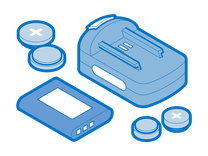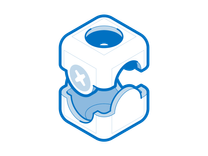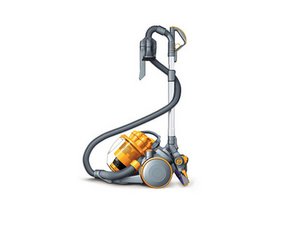Initial Considerations
What kind of Dyson vacuum do you have?
The various Dyson models (and there are quite a number) have used several different brush roll drive mechanisms, some more complicated and some, less so. Knowing what you might be facing can help you know what to look for.
- Upright Vacuums have used either a belt drive from the main vacuum motor or a separate brush drive motor.
- Models from 2005 and earlier used a drive from the main motor, through a belt to a clutch and then to another belt to the brush roller. Either belt can fail, and stop your brush roll from spinning.
- After 2005 the brush rolls have their own drive motor.
- Canister vacuums have used either motor driven brush heads and airflow or turbine driven brush heads.
- The earliest models were electric, then they were switched to air driven with the DC08 in 2002.
- The DC21 reintroduced the motorized head in 2008.
- Stick (cordless) vacuums have sometimes used a motorized brush head, with the newer models (V8 and later) using a special motor that directly drives the brushroll with no belt needed. The brush head adversely affects battery life for these units.
Causes
If you have a cordless model, your battery may be completely dead. Some units have a motor cutoff if the battery is too low.
- Plug the unit into the charger for an hour, and test the vacuum again. If the battery still is not charged, test the charger in a different location.
- If the charger seems to work, consider replacing your vacuum battery with a new one.

Find compatible replacement parts for your Dyson Vacuum. All parts and fix kits are backed by the iFixit Quality Guarantee.
Does your vacuum have a hard floor setting that shuts off the brush rolls?
If so, make sure it isn't turned on. If it is, turn it off and see if your brush rolls work. Many Dyson units have this feature.
Most units also feature a switch which prevents the brush roll from spinning when the vacuum is in the upright position. Take your vacuum out of the upright position and see if the brush rolls spin.
Is the brush roll loaded with hair, string and other debris? This can stop it from turning, and on belt driven models may result in a belt that slips, falls off or breaks over time.
- Unplug your vacuum or remove the battery if possible, and clean the brush roll fully. You may have to do some minor disassembly.
- On Dyson vacuums there are several ways that the brush roll comes off,
- Often there is an end cap that is removable and you can slide the roll out.
- Some models have two-piece brush rolls. Each piece comes out from the end.
You will want scissors and possibly pliers to remove everything. There are tools that are like a letter opener with a shrouded blade that allow you to cut the hairs with less chance of damaging the brushes.
- After cleaning, test the unit, do the rolls spin now? If so, you are done.
- If they don't spin, check to see if the brush roll head has a reset button.
- If the brush roll is damaged it may need to be replaced with a new one.

Find compatible replacement parts for your Dyson Vacuum. All parts and fix kits are backed by the iFixit Quality Guarantee.
Most newer Dyson Uprights are two motor vacuums. The brush rolls are driven by a dedicated motor and the motor can stall and trip the thermal protection. You must push the reset button to start them after cleaning.
Some Dyson uprights will not have this button but can be reset by switching on the machine and reclining the vacuum.
Is your vacuum set to the right pile height for the carpet?
- Check the setting on your vacuum. Can it be adjusted?
- If it is automatic and can't be adjusted normally check these items.
- Check to see that the auto adjust (Muscle Head, for example) is working properly, it may be that the adjustment isn't working, and will need repair or replacement.
- Try to override the adjustment if possible.
- Reduce the suction if the carpet is too deep, and you have no other options.
- If it can be adjusted, make sure it isn't set to a low pile setting with high pile carpet.
- The brushes can be overwhelmed and won't spin. Raise the setting. This can happen especially with cordless models that have less powerful brush rolls.
- On some models you may need to both raise the setting and lower the suction or power.
- In some instances this can also be made worse by loose carpet. Vacuums with powerful suction can pull the carpet so strongly that it prevents the brush roll from turning.
Many, if not most, Dyson vacuums use electrically driven brush rolls. The electric circuit for the brush rolls in the head of the vacuum runs through a number of connectors, which can be found in the hose or wand on the vacuum.
- Motor driven brushes have internal wires that run down to the brush head.
- Each joint on the hose will have an electrical connection.
- The connection between the brush roll head and the vacuum body on the upright models will have a connector.
- Look for two pins or other kind of connector at each joint.
- If you can find them you have a motor-driven brush head.
Is the motor running still without turning the brush roll or has it stopped? If it's running, but the rolls don't turn, the drive belt is broken, jump to that section.
If stopped, are the connectors dirty or bent?
- Clean and straighten them. You may have to replace parts if the connectors can't be straightened.
- The cordless vacuums can have a connector between the canister and the vacuum body that can get dirty and keep the brush roll from spinning.
- You will have several connections to check starting at the canister and at each joint as you go to the brush head.
- Clean them as you go with contact cleaner; this is a maintenance item.
Turbine Head Brushes Not Spinning?
Dyson has a number of heads that use air turbines. With any turbine driven head, airflow is the driving power. Clogs in the air passages interfere with this.
Do you have a turbine brush? Air turbine driven brushes won't have a power cord or connectors, and will frequently be smaller. Many Dyson canister vacuums have them, instead of a motor driven head, and newer vacuums have motorized heads.
If you have a turbine brush there are several things to consider:
- They are more prone to stalling, especially on dense or higher pile carpet.
- Check the hose for holes and see if your suction control is open, which will affect the brush rolls.
- Air turbine driven brushes are greatly affected by a plugged hose. Since full airflow is needed for them to work best, they will stop much more easily when there is a clog in the vacuum hose. Check your whole hose for clogs when the brushes seem to lack power or stop.
- Turbine driven brushes are very sensitive to hair wrapped around an end bearing. Disassemble your unit further and check the bearings at the end of the brush roll, even if the roll looks clean. Hair and fibers can hide in the bearings.
If you have cleaned your brush roll and checked the height setting, the brush roll may still run poorly at this point or not at all.
Check the bearings on the brush roll to determine if they have failed. They may be noisy, or won't spin smoothly by hand after being cleaned. These are symptoms of bad or dirty bearings.
- Remove the brush roll or rolls from the vacuum.
- Check to see that the bearings at the end of the brush roll allow free spinning.
- Remove any hair trapped in the bearings.
A number of Dyson brush rolls (usually on canister models) are driven by an air turbine. These models are more sensitive to having their bearings clogged with hair.
The bearing at the brush roll driver (located at the opposite end from where the roll can be removed) frequently can have hair wrapped around it, and the hair can't be removed without some disassembly.
- You can get to the bearing by removing a screw that is down inside a hole on the end of the spiral/conical drive piece. This is located at the end of the brush roll housing. The screw has a T-8 head, like other fasteners on the vacuum.
- You will likely have to partially disassemble the brush roll head to more easily access this screw. Once you remove the screw, the drive piece can be removed and the hair trapped under it can be removed. Reassembly is the opposite procedure.
Note: If the rolls spin freely after checking the bearings, test the unit to see if they spin under power now, if they do smoothly, you're done. If they are noisy or vibrate badly, you need new bearings.
If your brush roll is driven by a belt, it will not turn if the belt is broken. One helpful sign of this is that you will hear the brush roll motor running, but the brushes won't turn.
- Check the drive belt for your vacuum. On older uprights this will require some disassembly.
- Also as you are checking the brush roll to clean it, check the belt at the same time since you have to remove it to take off the brush roll.
- If the belt is broken, replace it.



